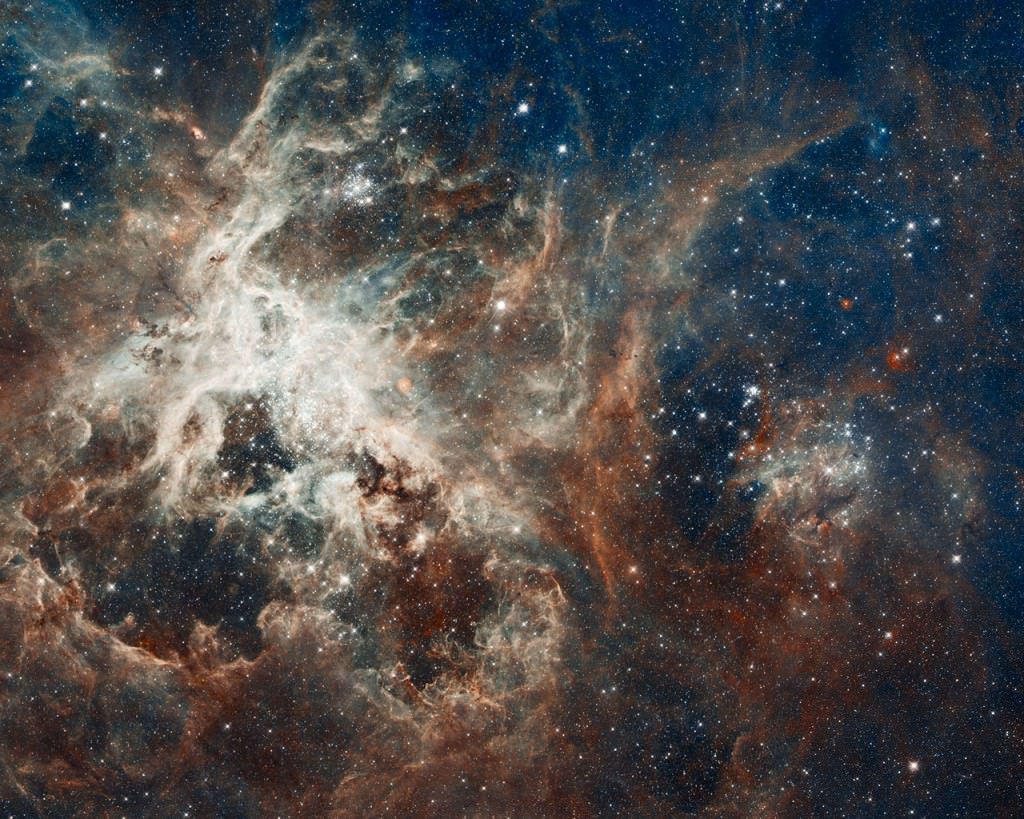When it comes to exciting places to look in the sky, the Tarantula Nebula is hard to beat. It’s got cloudy star-forming regions, hot young stars, and star clusters. It’s one of the brightest and most active star birth areas in the Milky Way’s neighborhood.
It’s also got an amazing collection of massive stars. That range of stellar activity makes the Tarantula almost the perfect laboratory to study the mechanics of star formation. It’s also worth noting that in a fairly short few tens of millions of years, it’ll be a great place to watch supernovae popping off.
So, what better way to celebrate this Southern Hemisphere sky treat than a new image of the Tarantula (also known as 30 Doradus)? The one below contains recent ground-based data from the Atacama Large Millimeter/submillimeter Array (ALMA) in Chile. It’s worthy of a closeup look, so feast your eyes! This composite image shows the star-forming region 30 Doradus, also known as the Tarantula Nebula. The background image, taken in the infrared, is itself a composite: it was captured by the HAWK-I instrument on ESO’s Very Large Telescope (VLT) and the Visible and Infrared Survey Telescope for Astronomy (VISTA), shows bright stars and light, pinkish clouds of hot gas.
The bright red-yellow streaks that have been superimposed on the image come from radio observations taken by the Atacama Large Millimeter/submillimeter Array (ALMA), revealing regions of cold, dense gas which have the potential to collapse and form stars. The unique web-like structure of the gas clouds led astronomers to the nebula’s spidery nickname. Details in the Tarantula So, what are we looking at? This bright shiny image highlights wispy gas clouds that provide insight into how massive stars shape the Tarantula Nebula region.
“These fragments may be the remains of once-larger clouds that have been shredded by the enormous energy being released by young and massive stars, a process dubbed feedback,” suggested Tony Wong, who led the research on 30 Doradus. He presented his team’s work at the American Astronomical Society (AAS) meeting. The new image may change ideas about the gas in the nebula.
Astronomers originally thought it would be too sparse and too overwhelmed by that turbulent feedback. That might make it difficult for gravity to pull it together to form new stars. But the new data also reveal much denser filaments where gravity’s role is still significant.
“Our results imply that even in the presence of very strong feedback, gravity can exert a strong influence and lead to a continuation of star formation,” said Wong, who is a professor at the University of Illinois at Urbana-Champaign. More about the Tarantula This nebula is pretty familiar to southern hemisphere observers. It lies in the Large Magellanic Cloud, a satellite galaxy of our own Milky Way.
The Tarantula is about 170,000 light-years away from Earth. That may sound pretty distant, and it is. However, it’s still close enough for astronomers to study starforming there in decent detail.
And, it’s a great stand-in for other places in the universe where stars were born. “Its properties are similar to those found in very distant galaxies when the Universe was young,” said Guido De Marchi, a scientist at the European Space Agency (ESA) and a co-author of a paper presenting the new research. “Thanks to 30 Doradus, we can study how stars used to form 10 billion years ago when most stars were born.
” Zeroing In on the Tarantula using a Large-Millimeter Array and a Poison Gas The team conducted high-resolution observations using ALMA covering a large region of the nebula. They measured the emission of light from carbon monoxide gas. That gas helps trace large, cold clouds in the nebula.
These are the ones that eventually coalesce to form stars. The presence (or absence) of carbon monoxide gas is interesting. It turns out to be a fair indicator of the star formation process and how that process changes the environment.
“We were expecting to find that parts of the cloud closest to the young massive stars would show the clearest signs of gravity being overwhelmed by feedback,” said Wong. “We found instead that gravity is still important in these feedback-exposed regions — at least for parts of the cloud that are sufficiently dense. ” This recent research also contains detailed clues about how gravity behaves in the Tarantula Nebula’s star-forming regions.
The work is far from finished. The next steps should be to survey more of the Tarantula and use that information to examine more distant early star-forming regions in the Universe. For More Information The Tarantula’s cosmic web: astronomers map violent star formation in nebula outside our galaxy The research is also presented in the paper “The 30 Doradus Molecular Cloud at 0.
4 Parsec Resolution with ALMA: Physical Properties and the Boundedness of CO Emitting Structures” to appear in The Astrophysical Journal. The post See a Stunning New Picture of the Tarantula Nebula appeared first on Universe Today. .
From: universetoday
URL: https://www.universetoday.com/156324/see-a-stunning-new-picture-of-the-tarantula-nebula/



